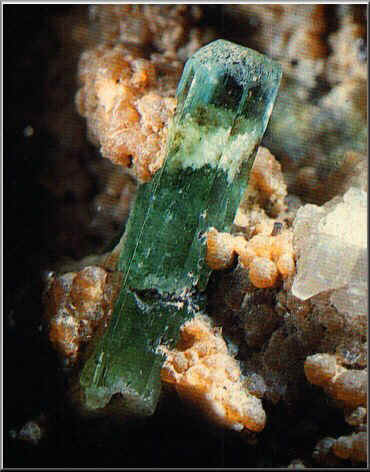by Ronald Werner
INTRODUCTIONLocated at the shore of Lake Mjøsa -Norway’s largest lake- is one of the very few European occurrences of emeralds in gemstone quality. The deposit was discovered around 1880. An English mining company - “The Norwegian & General Exploration Company LTD”- operated the deposit from 1899 till 1909. The mines were abandoned after only ten years of operation, due to the low productivity of the mines and the low quality of the emeralds.
There is a persisting rumor that one of the emeralds in the
crown of the English queen is from Byrud. Whether or not this is
true might be hard to establish, while the records of the mining
company so far remain unfound. True, however, is that thousands of
collectors through the years have visited the mines, and
successfully dug for emeralds. And still the dumps continue to yield
emeralds, if perhaps usually not in gemstone quality. |
| The emerald-bearing pegmatite’s are located at the north-western border of the Oslo Rift Valley. This rift valley of Permian age (280-230 m.Y.) is characterized by extensive alkalic igneous activity. The pegmatite’s have a composition corresponding with the rock called “nordmarkite”, an alkali-syenite. A large nordmarkite massive, not far to the west, is considered to be the source of the pegmatitic fluids. The flat-lying pegmatite’s were injected in alum-shale of Cambrian age. At Byrud the pegmatite’s have been worked over a distance of 200 meters. The pegmatite’s are of relatively simple composition, and consist mainly of fine-grained, grayish to coarse, white feldspar, minor quartz, and subordinate amounts of fluorite, beryl and topaz. |
| The composition of the pegmatite’s is,
as said above, relatively simple. Publications about Byrud are
scarce, incomplete and outdated. Actually, the most comprehensive
description dates back from 1911, a small chapter in V.M.
Goldschmidt’s “Die Kontaktmetamorphose im Christianiagebiet”. G.
Raade & J. Haug have a comprehensive publication in preparation.
I base the systematic description in the first place on Goldschmidt
and my own observations.
The sulfides are represented by pyrite, pyrrhotite and molybdenite. The quantity of sulfide minerals is minimal, and none of them occurs as collectable specimens. Pyrrhotite occurs as bronze-brown massive mineral. Every now and then, when breaking up material in search of good micro-crystals of emerald, 6-sided plates of molybdenite, less than 1 mm in size, are found. The halogenides are represented by fluorite only, and cannot be considered to be of major interest to collectors. Colorless to purple masses of fluorite are found widespread in small quantities. I was informed that crystals have been found, but that these are quite rare. The oxides are represented by ilmenorutile, which occurs sparingly but widespread, as small 1-5 mm, metallic black crystals. The idenitification is based on a personal communication. The habit of the crystals is generally blocky, and because the crystals are generally embedded in feldspar, it is often impossible to determine the faces at the crystals. Free-grown crystals in miaroles are somewhat rarer. The silicates are the largest group, and are represented by albite, bavenite, beryl, microcline/orthoclase, muscovite (often as “sericite”), quartz and topaz. Albite, microcline/orthoclase, muscovite and quartz are of little interest to collectors. Bavenite occurs as radiating groups of white/colorless, thin-tabular, prismatic crystals of max. 1-2 mm’s in miarolitic cavities in the feldspar. Bavenite is rare. Beryl is by far the most spectacular mineral. The color varies from yellow, green to intensive blue. The majority of the beryl is found as emerald in all kind of shades of green. From pale to intensive green, from translucent to absolutely clear. Large emerald crystals of true gem quality are nowadays extremely rare, and I found only one. But small emerald crystals up to 5 mm of length and with a thickness of 1-2 mm of gem quality are not really hard to find. Especially nice are the even smaller, free-standing emerald crystals in miarolitic cavities in the feldspar. Important detail, is that the coloring agent in the beryl from Byrud is vanadium, and not chromium. The vanadium is derived from the shale’s in which the pegmatite’s were injected, and which contain a significant amount of this element. Blue colored beryl -aquamarine- is very rare at Byrud: after several visits I found no more than 2 specimens. Topaz is after beryl the most interesting mineral from Byrud. The mineral is definitely not rare, but is easily overseen by collectors who concentrate on finding emeralds. Often you will find large masses of small, colorless, intergrown topaz-crystals. With a bit of luck you might manage to prepare a couple of complete, well-developed crystals outof such pieces. The average size of such crystals is around 0,5 till 1 cm, but occasionally crystals up to 3-4 cm can be found. Very rare are free-standing topaz-crystals in miarolitic cavities of the pegmatite. I have been witness to someone finding a waterclear, perfectly developed 1,5 cm crystal some years ago. Characteristic forms of the topaz-crystals are (110), (011) and (001), but a multitude of additional forms may be observed on individual crystals. |
| The emerald mines of Byrud are among
the most spectacular geological attractions in Norway, and are worth
a visit. The mines are accessible as a tourist-attraction, and a fee
of 60,- Norwegian Krones must be paid in order to be allowed to
collect emeralds.
I visited the occurrence on several occasions and always found good material. Especially the chances to find micro-crystals are still good, while most collecters prefer larger sizes. |
| -Goldschmidt, V.M. (1911): “Die
Kontaktmetamorphose im Christianiagebiet”
-Ljøstad, O.T.: personal communication -Wilke, H.-J. (1976): Mineral-Fundstellen, Band 4, Skandinavien. -Picture of emerald by Rainier Bode, courtesy of the Norsk Bergverksmuseum |
